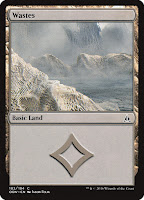 |
| colorless mana; image from here |
Continuing the color-based theme (see previous post), today we look at colorless mana.
Magic has five colors of mana (white, blue, black, red, and green). I explored these colors a few years ago, concluding with a brief look at colorless mana. I clarify and expand on that today.
Every non-land card in Magic has a mana cost, which shows the type(s) and number of mana required to play the card. From the comprehensive rules,
202.1a The mana cost of an object represents what a player must spend from their mana pool to cast that card. Unless an object’s mana cost includes Phyrexian mana symbols (see rule 107.4f), paying that mana cost requires matching the type of any colored or colorless mana symbols as well as paying the generic mana indicated in the cost.
Generic mana is spelled out earlier in the document:
107.4b Numerical symbols (such as {1}) and variable symbols (such as {X}) represent generic mana in costs. Generic mana in costs can be paid with any type of mana.
In the below four examples,
- Serra Angel costs 2 white mana and 3 generic mana
- Fugitive Wizard costs 1 blue mana
- Seismic Assault costs 3 red mana
- Jayemdae Tome costs 4 generic mana
Generic mana costs are always denoted by a number (or the variable 'X') inside a gray circle. So far, this is intuitive. And today's rules address both colored and colorless mana, but it wasn't always so—and that got confusing fast.
The problem started in the first set (Alpha) with cards that generated colorless mana. Consider Sol Ring:Sol Ring adds colorless mana to your mana pool. What was 'colorless' mana? Conceptually, we get that it is mana that lacked color, so it could be used only to pay generic mana costs in spells. But every other type of mana had a corresponding symbol. Colorless did not. This got more confusing as time went on. Looking at a later version of Sol Ring:
"Add {2} to your mana pool." But {2}, per rule 107.4b above, represented generic mana, which was technically any color of mana. That's not what Sol Ring is doing. It is adding colorless, which is distinct from generic. This needed to be clarified. They finally did so in 2015 with the release of Oath of the Gatewatch. They gave colorless mana its own symbol, created a basic land type (called "Wastes"), and started producing cards with colorless mana symbols in their casting costs (see below examples or peruse the entire set):You can still pay a generic mana cost using colored or colorless mana, but any card with colorless mana symbol(s) in its casting cost requires that amount of colorless mana. For cards that produce colorless mana, they updated in subsequent printings. Here are more recent versions of Sol Ring:
The first has the two colorless mana symbols. The second has the same, but omits the "to your mana pool" wording (they eliminated that in 2018, with Dominaria's release, for simplicity). That is the current presentation.Thanks to the aforementioned changes, colorless vs. generic mana is no longer confusing (or as confusing, anyway). It is one small example how the game continues to evolve, even decades after its introduction. It is also a testament to the diligence of the design team, whose continued tweaks are largely for the better.











No comments:
Post a Comment